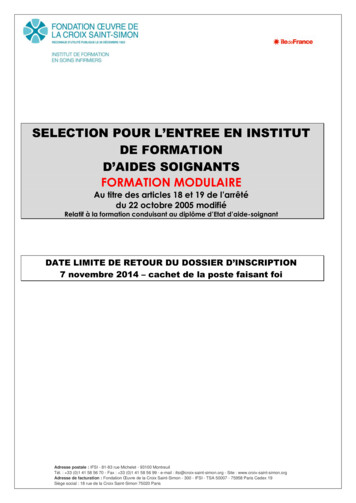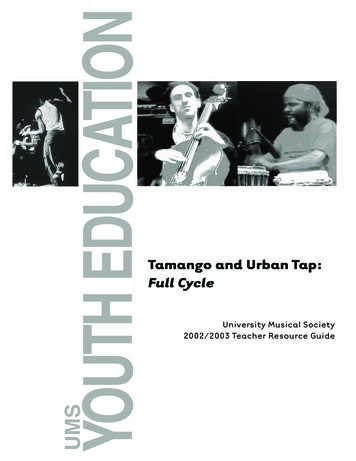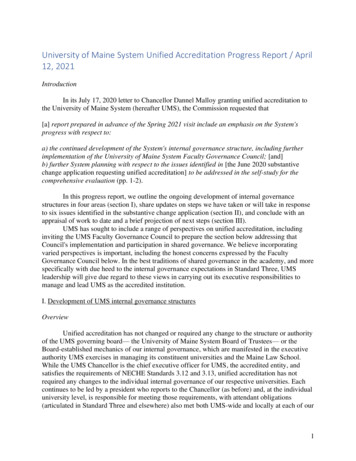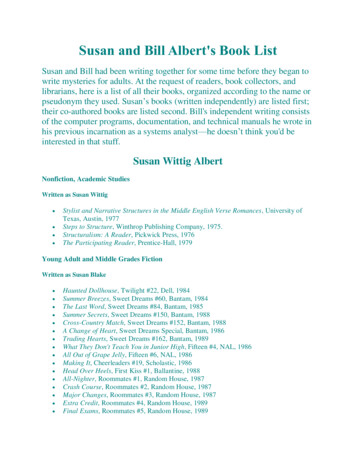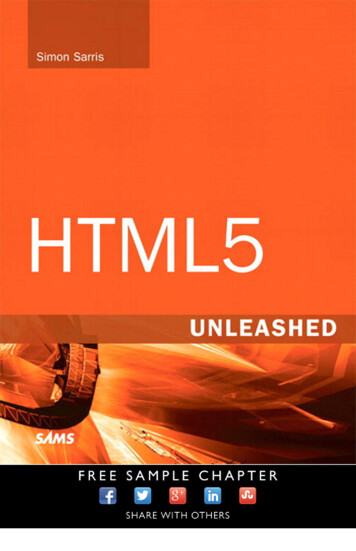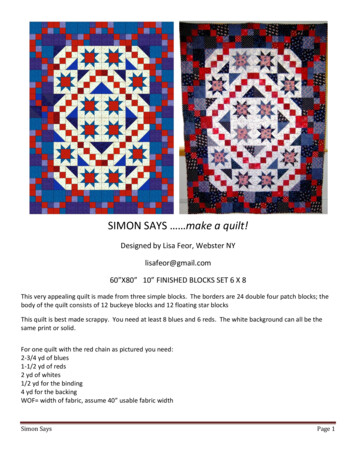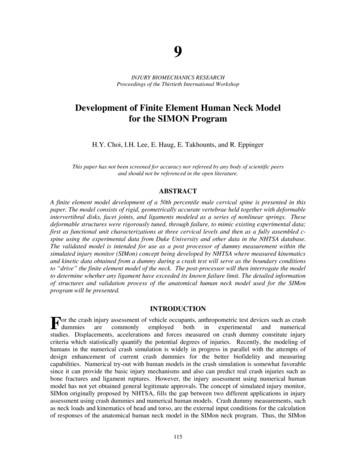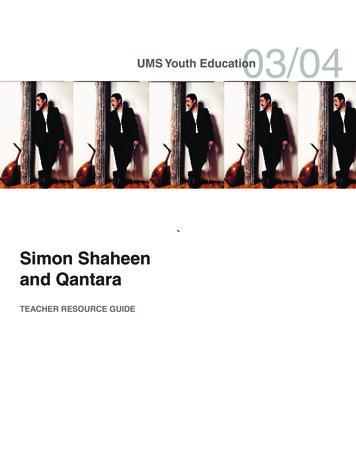
Transcription
03/04UMS Youth EducationSimon Shaheenand QantaraTEACHER RESOURCE GUIDE
About UMSUMS celebrates its 125th Season! One of the oldestperforming arts presenters in the country, UMS servesdiverse audiences through multi-disciplinary performing arts programs in three distinct but interrelatedareas: presentation, creation, and education.With a program steeped in music, dance, and theater, UMS hosts approximately 80 performances and150 free educational activities each season. UMSalso commissions new work, sponsors artist residencies, and organizes collaborative projects with local,national, and international partners.While proudly affiliated with the University of Michigan and housed on the Ann Arbor campus, UMS isa separate not-for-profit organization that supportsitself from ticket sales, grants, contributions, andendowment income.UMS Education and AudienceDevelopment DepartmentUMS’s Education and Audience Development Department seeks to deepen the relationship between audiences and art, as well as to increase the impact thatthe performing arts can have on schools and community. The program seeks to create and present thehighest quality arts education experience to a broadspectrum of community constituencies, proceeding inthe spirit of partnership and collaboration.The Department coordinates dozens of events withover 100 partners that reach more than 50,000people annually. It oversees a dynamic, comprehensive program encompassing workshops, in-schoolvisits, master classes, lectures, youth and family programming, teacher professional development workshops, and “meet the artist” opportunities, cultivatingnew audiences while engaging existing ones.We would like to give special thanksto the sponsors and supporters of theUMS Youth Education Program:Ford Motor Company FundMichigan Council for Arts and Cultural AffairsUniversity of MichiganAssociation of Performing Arts PresentersArts Partners ProgramBorders GroupCharles Reinhart Company, RealtorsCommunity Foundation for Southeastern MichiganDoris Duke Charitable FoundationDTE Energy FoundationFord FoundationForest Health Services/Mary and Randall PittmanMaxine and Stuart Frankel FoundationGelman Educational FoundationHeartland Arts FundJazzNetKeyBankMASCO CorporationTHE MOSAIC FOUNDATION (of R. and P. HeydonNational Dance Project of theNew England Foundation for the ArtsNational Endowment for the ArtsOffice of the Provost, University of MichiganPfizer Global Research and Development,Ann Arbor LaboratoriesThe Power FoundationProQuestTCF BankTIAA-CREFUMS Advisory CommitteeWallace-Reader’s Digest FundsWhitney FundDetails about educational events for the 03/04 seasonare announced a few months prior to each event.To receive information about educational eventsby email, sign up for the UMS E-Mail Club atwww.ums.org.For advance notice of Youth Education events,join the UMS Teachers email list by emailngumsyouth@umich.edu.This Teacher Resource Guide is a product of the University Musical Society’s YouthEducation Program. Much of the content was provided by Simon Shaheen. Additionalmaterials provided by ACCESS and Dawn Elder, Dawn Elder Management. Some lessonplans and powerpoint presentations were contributed by students enrolled in Dr. JulieTaylor’s multicultural education course at the University of Michigan, Dearborn. Allphotos are courtesy of the artists unless otherwise noted.
03/04UMS Youth EducationSimon Shaheen andQantaraTEACHER RESOURCE GUIDEYouth PerformanceFriday, January 30, 200411 am - 12 noonMichigan Theater, Ann Arbor
Table of ContentsOverviewShort on Time?We’ve starred the mostimportant pages.Only Have15 Minutes?**Coming to the ShowThe Performance at a GlanceSimon Shaheen10Simon Shaheen: A Biography12Qantara: Meet the MusiciansThe Arab Culture141722262829Try these:Word Search pg. 34Appreciating thePerformance pg. 3567Arabic MusicThe Genres of Arabic MusicArabic LanguageArabic CountriesArabic DancingCommonly Used MelodyLesson Plans***3233353638394041424344454647484950Lesson Plan OverviewMeeting Michigan StandardsUsing MultimediaArabic Music VocabularyArabic Music Vocabulary Word-OFoods of the Arab WorldArabic Cooking TermsK-W-L Chart for Arabic FoodsAn Arabic Food PyramidA Creative Look at Arab CultureThe Geography of the Arab WorldAppreciating the PerformanceArabic Music Word SearchArabic Music Word Search SolutionCreate Your Own UMSAdditional Lesson Plan IdeasStill More Ideas.Arabic Folktales5253Understanding FolktalesArabic FolktalesResources*4 www.ums.org/education58606263656566UMS Permission SlipInternet ResourcesRecommended Reading MaterialsSelected BibliographyCommunity ResourcesEvening Performance/ Teen TicketUMS Youth Education Season
OVERVIEW
Coming to the ShowWe want you to enjoy your time in the theater, so here are some tips to make your YouthPerformance experience successful and fun! Please review this page prior to attending theperformance.Where do we get off the bus? You will park your car or bus in the place marked on yourteacher’s map. Only Ann Arbor Public Schools students and students with disabilities will bedropped off in front of the theater.Who will meet us when we arrive? UMS Education staff and greeters will be outsideto meet you. They might have special directions for you, so be listening and follow theirdirections. They will take you to the theater door, where ushers will meet your group. Theushers know that your group is coming, so there’s no need for you to have tickets.Who shows us where we sit? The ushers will walk your group to its seats. Please takethe first seat available. (When everybody’s seated, your teacher will decide if you can rearrange yourselves.) If you need to make a trip to the restroom before the show starts, askyour teacher.How will I know that the show is starting? You will know that the show is startingbecause you will see the lights in the auditorium get dim, and a member of the UMS Education staff will come out on stage to say hello. He or she will introduce the performance.What if I get lost? Please ask an usher or a UMS staff member for help. You will recognizethese adults because they have name tag stickers or a name tag hanging around their neck.What do I do during the show?Everyone is expected to be a good audience member. This keeps the show fun for everyone.Good audience members. Are good listeners Keep their hands and feet to themselves Do not talk or whisper during the performance Laugh at the parts that are funny Do not eat gum, candy, food or drink in the theater Stay in their seats during the performance Do not disturb their neighbors or other schools in attendanceHow do I show that I liked what I saw and heard? As a general rule, the audienceshows appreciation during a performance by clapping. This clapping, called applause, ishow you show how much you liked the show. Applause says, “Thank you! You’re great!”In a musical performance, the musicians and dancers are often greeted with applause whenthey first appear. It is traditional to applaud at the end of each musical selection, and sometimes after impressive solos. Sometimes at music performances, the audience is encouragedto stand and clap along with the music in rhythm. At the end of the show, the performerswill bow and be rewarded with your applause. If you really enjoy the show, give the performers a standing ovation by standing up and clapping during the bows.What do I do after the show ends? Please stay in your seats after the performance ends,even if there are just a few of you in your group. Someone from UMS will come onstageand announce the names of all the schools. When you hear your school’s name called,follow your teachers out of the auditorium, out of the theater and back to your buses.6 www.ums.org/educationHow can I let the performers know what I thought? We want to know what youthought of your experience at a UMS Youth Performance. After the performance, we hopethat you will be able to discuss what you saw with your class. What did your friends enjoy?What didn’t they like? What did they learn from the show? Tell us about your experiencesin a letter, review, or drawing. We can share your feedback with artists and funders whomake these productions possible. Please send your opinions, letters or artwork to: UMSYouth Education Program, 881 N. University Ave., Ann Arbor, MI 48109-1011.
The Performance at a GlanceWho is Simon Shaheen?Born in Galilee, Simon Shaheen is a composer and master oud player andviolinist. Simon (pronounced “se-moan sha’ heen”) began studying theoud at the age of five, and one year later, Simon began studying violin.Today, he resides in New York and is the Director of the Near Eastern MusicEnsemble. He is also one of the leading organizers of New York’s annualmahrajan Al-fan, a two-day festival of Arab world culture. Recently, he hasfocused much of his energy on Qantara (see below) over the past few years.Qantara (pronounced “Kahn’ terrah”)is his band which bridges the gapbetween many different cultural styles of music, in a genre known as “jazzfusion.” An acclaimed Arabic music performer, composer and instructor,Shaheen tours worldwide as a soloist and with his ensembles, Qantara, andthe Near Eastern Music Ensemble. His recordings (see page---) have wonhim an international reputation as a leading Arab musician of his generation. A master instructor in performance and theory, Shaheen lectures frequently at universities in the U.S.Who is Qantara?“Simon Shaheenmay well be one ofthe finest culturalambassadors theArab world has.”-Hank Bordowitz,Reflex MagazineThe word Qantara (pronounced “con-tra”) describes an archway used inArabic architecture or bridge. Qantara is a group of musicians under thedirection of Simon Shaheen, who take the idea of “jazz fusion” to a newlevel. Qantara embraces Simon Shaheen’s vision of the unbridled fusion, orblending, of Arabic, Jazz Improvisation, Western Classical, and Latin music.The musicians in Qantara for our Youth Performance are Jamey Haddad,Bassam Saba, Steve Sheehan, Thomas Bramerie, Najib Shaheen, AntonioEscapa, and Brad Shepic.What is Jazz Fusion?The word “fusion” is described in many dictionaries as the act of meltingor union. The term “jazz fusion” can be described as a melting or unionof several different types of music genres with jazz. Jazz originally developed from gospel, work-songs, and rhythm and blues, and is considered bysome to be the “classical” music of America. Over the years, jazz has beenthrough its own evolution from conventional forms of modal jazz at theturn of the century through the 1930’s, to the 1950’s bebop and avant gard“free jazz.” During the 1960’s and 1970’s, jazz music was influenced bythe influx and popularity of rock bands Since jazz and rock share the samebasic roots, that is, rhythm and blues, it was a natural progression for jazzmusicians of the day to begin developing rock rhythms. Musicians such asMiles Davis, Herbie Hancock, Chick Corea, and Charles Lloyd all producedthe astonishingly fresh sound soon to be known as jazz-rock fusion. Alongwith this new direction in jazz, the use of electronic equipment such as theamplifier and synthesizer gave chords a rich sound and provided texture tothe jazz rhythms.Today, Jazz fusion has developed into a multi-faceted genre, combining themusical styles of many different countries and cultures. Jazz fusion artistslike Simon Shaheen and Qantara are forerunners in this innovative new concept in music. It is no longer simply a union of rock, rhythm, and blues, butan eclectic blend of Jazz, Arabic, Western Classical, and Latin music.7 www.ums.org/education
The Performance at a GlanceWhat is an Oud?For moreinformation onSimon Shaheenand Qantara,visitwww.simon-shaheen.comThe oud is a pear-shaped wooden instrument with eleven strings. The oudis also known as a lute, in European and western cultures. The English wordlute is derived from the Spanish word laud, which originated from the Arabical-’ud, which literally means “branch of wood.” Also called laute in German,and le luth in French, the oud is considered to be the grandparent of westernguitars and mandolins. It was the first instrument to have a wooden facerather than a face made from animal skin. The ‘oud is the leading instrument in the takhet (orchestra), which became very popular in Europe duringthe sixteenth and seventeenth centuries, but by the middle of the eighteenthcentury, the guitar became the oud’s rival. The guitar soon won out since itwas simpler to construct and less cumbersome to hold.What are other instruments you might see and hear?Some of the other instruments you might hear at the performance are theflute, the nay (a type of woodwind instrument), the kamanjah or kaman(violin), the bass, the guitar, the riqq (tambourine), the mizhar, and the tablan(two types of drums). These instruments form an ensemble called a takht inArabic. Typically takhts do not have a guitar, but rather a quanun (see page20 for further descriptions and pictures of these instruments.)What songs will you hear at the performance?Simon Shaheen and Qantara will be performing traditional Arabic melodies,called maqamat, as well as original pieces of music he has composed. Theoriginal pieces he has composed include one piece called “Waving Sands”which is a great introduction to jazz fusion. In this piece you can clearly hearthe traditional Arabic melody infused with jazz instruments like the guitarand the bass, into Latino rhythms. The traditional songs you will hear haveoriginated from such places as Saudi Arabia, Lebanon, and Egypt. Like Jazzmusic, much of Arabic music is improvised, and so the songs at the performance will be announced from the stage. You may be asked to clap a fewrhythms, or maybe even asked to try a few dance steps at your seat. (Butplease, remain respectful of the performance and do not attempt this untilasked to do so by Mr. Shaheen.)Why does Arabic music sound out of tune to Western ears?Although Arab music contains many melodies, none of the instruments specifically pay in harmony, which is what Western ears are trained to hear. TheArab music scales have many more notes than the Western classical majorand minor scales. For a further description, please refer to page of thisguide.8 www.ums.org/education
SIMON SHA HEENPhoto courtesy of DE Management
Simon Shaheen: A Biography“When I heldand playedtheseinstruments,they felt like anextension ofme.”-Simon ShaheenDazzling listeners with his soaring technique, melodic ingenuity and theunparalleled grace, which he deftly leaps from traditional Arabic to jazzand classical styles. Simon Shaheen has earned international acclaim as avirtuoso on the oud and violin.Shaheen is also one of the most significant Arabic musicians, performersand composers of his generation. His work not only looks back on the history of Arabic music, but also continues to push forward, embracing manydifferent styles in the process. This unique contribution to the world ofarts was recognized in 1994 when Shaheen was honored with the prestigious National Heritage Award.In the 1990’s he released four albums of his own: Saltanah (Water LilyAcoustics), Turath (CMP), Taqasim (Lyrichord), and Simon Shaheen: TheMusic of Mohamed Abdel Wahab (Axiom). He also contributed cuts toproducer Bill Laswell’s fusion collective Hallucination Engine (Island) andmusic to the soundtracks for The Sheltering Sky, Malcolm XX, and others,while he wrote music for the entire soundtrack of the documentary ForEveryone Everywhere. Broadcast globally in December 1998, this film celebrated the 50th anniversary of the United Nation’s Human Rights CharterRecently, Shaheen wrote the music for the documentary of the BritishMuseum’s Egyptian collection. Beginning in the fall of 2001, the collectionwill tour U.S. museums for three years; the documentary will be an integral part of the exhibit’s introduction for audiences.Born in Tarshiha, Galilee, in 1955, Simon Shaheen grew up surrounded bymusic. His father, Hikmat Shaheen, was a professor of music and a masteroud player. Simon began learning the instrument at the age of five, and ayear later began studying violin at the Conservatory for Western ClassicalMusic. Simon Shaheen credits his father as being the predominantlyinfluence on his music.After graduating from the Academy of Music in Jerusalem in 1978, Shaheen was appointed Instructor of Arabic music, performance and theory.He moved to New York City two years later to complete his graduatestudies in performance at the Manhattan School of Music, and later inperformance and music education at Columbia University.In the early 80s, Shaheen formed the Near Eastern Music Ensemble establishing a group that would perform the most moving and highest standard of traditional Arabic music. This time also marked the beginning ofShaheen’s workshops and lecture/demonstrations in elementary schools,high schools, colleges, and universities to educate the younger generation. As a champion and guardian of Arabic music, Shaheen still devotesalmost fifty percent of his worktime to working with schools and universities, including Juilliard, Princeton, Brown, Harvard, Yale, UCSD and others.10 www.ums.org/education
His concert credits are a veritable compendium of the world’s greatestvenues, including Carnegie Hall, Kennedy Center, Cairo’s Opera House,Theatre de la Ville in Beirut, and Belgium’s Le Palais des Arts. In 2000 Shaheen appeared at the Grammy Awards with Sting, arranging the violin section for Stings’ live rendition of “Desert Rose.”As a composer, Shaheen has received grants from the National Endowmentfor the Arts, the New York State Council on the Arts; Meet the Composer,the Jerome Foundation, and Yellow Springs Institute. In addition to hisrecorded work, his theatrical repertoire includes Majnun Layla, (performedat Kennedy Center and The Museum of Natural History), The Book and theStranger (from the classic Arabic story Kalila and Dimna derived from theIndian Book of the Animals), Possible City (set in Cordoba during the Andalusian period), and Collateral Damage (a monologue by Vanessa Redgrave.For moreinformation onSimon Shaheen’srecordings, seepage 24 of thisstudy guide.Since 1994, Shaheen has produced the Annual Arab Festival of Arts, Mahrajan Al-Fan. Held in New York, the festival showcases a melody of thefinest Arabic artists, while presenting the scope, depth and quality of Arabicculture. And in 1997 Shaheen founded the Annual Arabic Music Retreat.Held each summer at Mount Holyoke College, this week-long intensiveprogram of Arabic music studies draws participants across the U.S. and theworld.For the past six years, Shaheen has focused much of his energies on Qantara. The band, whose name means arch in Arabic, is Shaheen’s vision ofthe unbridled fusion of Arabic, jazz, Western Classical and Latin music, aperfect alchemy meld where the music transcends the boundaries of genreand geography.“I want to create world music exceptionally satisfying to the ear and thesoul,” says Shaheen, which is why I selected members for Qantara whoare all virtuosos in their own musical form, whose experience can raise themusic and performance of the group to the spectacular.”Text used with permission from Simon Shaheen.11 www.ums.org/education
Qantara: Meet the Musicians“The musiciansof Qantara haveopen minds,great talent,questing soulsand flyingfingers.”- Simon ShaheenJamey Haddad PercussionA recipient of a Fulbright Fellowship and two National Endowment for theArts Fellowships, percussionist Haddad has appeared on more than 100recordings, performed with artists from Paul Simon to Paul Winter andDave Liebman, in addition to helping the Moroccan government developcompositions by Berber and Gnawan groups. He’s also the author ofGlobal Standard Time, and is an acknowledged expert on North Africanrhythms and percussion.Bassam Saba Flute and NayBorn in Lebanon, where he studied oud, nay, and violin at the LebaneseConservatory. After completing his studies, he moved to France, gettingfurther degrees, including a Master’s in Western Flute Performance. Aftera period as Musical Director of the Beirut Symphonic Band, he moved toNew York, where he is a member of the Near Eastern Music Ensemble,among many other musical activitiesSteve Sheehan PerscussionAn internationally lauded percussionist and composer, Sheehan was bornin the U.S. As well as 10 albums under his own name, he’s recorded withtalents as diverse as Herbie Hancock, Paul Simon, Brian Eno, Cheb Mami,Omar Farouk, Hector Zazou, and Juan Manuel Serrat. His explorations ofworld percussion techniques have taken him from Algeria to Indian, theAmazon, and beyond.Brad Shepic GuitarAdditional Information unavailableNajib Shaheen OudAn exceptional oud player who has worked with major Middle Eastern artists in the U.S. He has been a founder member of the Near Eastern MusicEnsemble and has been making ouds for more than a decadeAntonio Escapa PercussionTony Escapa is a drummer from Orlando, Florida, and the son of pianistand arranger Antonio Escapa, who played in Ricky Martin’s first group,Menudo. Tony started playing guitar at age ten and switched to drums atage 11. At a very young age, Tony won several awards, and performedat the Heineken Jazz Festival in San Juan in 1999. That summer, Tony wona 12,000 scholarship at the “Berklee in Puerto Rico” program, and performed in percussionist Egui Castrillo’s band.Thomas Bramerie BassThomas plays the bass, and has performed with Dee Dee Bridgewater onseveral recordings.12 www.ums.org/education
The Arab Cul ture
Arabic MusicCenturies of Cultivation“There is noharp withoutthe zither, noguitar with outthe ‘oud.”- Simon ShaheenThe identifying link of a people may be found not only in their language,but in their music as well. Throughout their long and illustrious history, theArabs have been lovers of music in its various forms. Music is an integralpart of daily life in the Arab World and sensibility to its sounds and tones isdeeply rooted in the Arab personality.Musical tradition in the Arab world is very old, dating back to the simplesing-song recitations of tribal bards in pre-Islamic days, usually accompaniedby the rababa, a primitive two-string fiddle. As they spread out into theMiddle East and North Africa in the seventh and eighth centuries A.D., theArabs quickly added the rich and complicated scales and tones of Indian,Persian and Byzantine music and developed a unique form that has persisted to this day with only minor changes. In that sense, Arabic music is aremarkably enduring art form which, after centuries of competing culturalinfluences, has retained an overall unity. Many of its sounds are alien toWestern ears, but the melodies have great emotive power for Arabs whocan recognize the variations in musical styles, from the famous maqaam ofIraq to the muwashah, a form of singing developed in Arab Spain duringthe Middle Ages and still used today.For several centuries, Arab rulers from Baghdad to Cordoba were famed fortheir patronage of music and musicians. Their courts boasted full orchestrasfor entertainment, while noted musicians competed for the ruler’s favor.The music of the Arabs gradually influenced the West. Masters such asBartok and Stravinsky composed works with detectable Eastern or Arabicinfluences. The Western world inherited not only the structure and tabulation of Arab music but also many of its instruments, which have evolvedinto such easily recognizable instruments as the violin, the mandolin, andthe tambourine.Today, there is a long history of Western artists being influenced by Arabicmusic. Mozart and Tchaikovsky were inspired by Middle Eastern music. Likewise, during the 1960s and 1970s, there was a belly dancing craze in theWest.How is Arab music structured?What makes Arab music sound so different from Western music? Theanswer lies in the structure of the rhythms. Arabic music uses melodicmodes called maqam (not just a scale, but also specific musical gesturesand emotional character, or ornamentation.) Arabic music is mostly heterophonic (or monophonic when one instrument is playing). There isno harmony. Arabic music sounds “out of tune” to many Westernersbecause it uses notes that are not in the 12-note Western scale. It useswhat are called “quarter tones” and “neutral tones.”Trichords are sets of 3 notes, tetrachords are sets of 4 notes, and pentachords are sets of 5 notes. The Arabic word for these sets is jins, (plural14 www.ums.org/education
ajnas), which means the gender, type or nature of something. In case ofpentachords, the word ‘aqd, plural ‘uqud is also used. These sets are thebuilding blocks for Arabic maqam. In Arabic music, a maqam (plural maqamat) is a set of notes with traditions that define relationships betweenmatthem, habitual patterns, and their melodic development. Maqamat are bestdefined and understood in the context of the rich Arabic music repertoire.The nearest equivalent in Western classical music would be a mode (e.g.major, minor, etc.).The Arabic scales which maqamat are built from are not even-tempered,unlike the chromatic scale used in Western classical music. Instead, 5thnotes are tuned based on the 3rd harmonic. The tuning of the remainingnotes entirely depends on the maqam. The reasons for this tuning are probably historically based on string instruments like the oud. A side effect ofnot having even-tempered tuning is that the same note may have a slightlydifferent pitch depending on which maqam it is played in.What is the difference between a maqam and a scale?The Arabic maqam is built on top of the Arabic scale (or dwar in Arabic).The maqam is generally made up of one octave (8 notes), although sometimes the maqam scale extends up to two octaves. But the maqam is muchmore than a scale: Each maqam may include microtonal variations such as tones, halftones and quarter tones in its underlying scale. These variationsmust be learned by listening not by reading, which is why the oraland aural tradition is essential in learning Arabic music.DID YOU KNOW:Among theearliest famousArab musiciansis theninth-centurycomposer andsinger Ziryab.He was born inBaghdad andis said to havememorized 1,000songs. Each maqam has a different character which conveys a mood, ina similar fashion to the mood in a Major or Minor scale, althoughthat mood is subjective to each listener. Since classical Arabic musicis mostly melodic (excludes harmony), the choice of maqam greatlyaffects the mood of the piece.· Unlike the two scales in Western music (major and minor scales),there are approximately 120 maqamat.· Each maqam includes rules that define its melodic developmentand which notes should be emphasized, how often, and in whatorder. This means that two maqamat that have the same tonalintervals but one is a transposed version of the other, may be playeddifferently. Each maqam includes rules that define the starting note, theending note, and the dominant note.15 www.ums.org/education
Arabic Music continued.Why does Arabic music sound out of tune to westernears?Visit UMS Onlinewww.ums.orgTo the Western ear, Arab music has a strange , exotic sound. Its notesseem closer together, and its melodies have a continuous, gliding quality.Arabic music is played in melody. The Western classical music like Bach,Beethoven, and Strauss we are accustomed to hearing is based on harmony. To achieve this horizontal sound without harmony, all of the musicians play essentially the same melody throughout the duration of eachsong. Variations in the sound occur as each musician adds ornamentation, such as trills and grace notes, to the melody he or she is playing.The art of adding ornamentation is known as zakhrafat in Arabic. Arabicmusic also uses notes that do not exist on our major and minor scales.The scales in Arab music have smaller intervals between notes. Thesenotes can be easily understood if you can imagine an 88 key piano withblack and white keys. Now, imagine in between the black and whitekeys are red keys. Not only are there red keys, but there maybe yellowkeys, and even blue keys! These notes may sound flat to us, but to anArab musician they are known as quarter tones. The scales in Arab musichave smaller intervals between notes, and we call these intervals “quartertones.”What exactly are quarter tones ?Many maqamat include notes that can be approximated with quartertones (depicted using the half-flat sign or the half-sharp sign), althoughthey rarely are precise quarters falling exactly halfway between two semitones. Even notes depicted as semitones sometimes include microtonalsubtleties depending on the maqam in which they are used. For thisreason, when writing Arabic music using the Western notation system,there is an understanding that the exact tuning of each note might varywith each maqam and must be learned by ear.Another peculiarity of maqamat is that the same note is not alwaysplayed with the same exact pitch, the pitch may slightly vary dependingon the melodic flow and what other notes are played before and afterthat note. The idea behind this effect is to round sharp corners in themelody by drawing the furthest notes nearer. There are literally thousands of maqamat from the various regions of the Arab world.16 www.ums.org/education
The Genres of Arabic MusicThe Sama’iThe Samai is a composed genre comprised of four sections (khana, pluralkhanat), each followed by the refrain (taslim). The samai composition demkhanatonstrates the 10/8 rhythmic mode (called sama’i thaqilthaqil) followed throughout the taslim and the first 3 khanat. The 4th khana, which precedes thelast statement of the refrain, is typically composed in a 3/4 or 6/4 rhythm,called Samai Darij. Some contemporary composers display a 5/8, 7/8 or 9/8rhythm in the 4th khana.The first three khanat of the Samai consist of 4 to 6 measures. The last(4th) khana varies from 6 to 24 measures. Generall, the first khana inthe Sa
Ann Arbor Laboratories The Power Foundation ProQuest TCF Bank TIAA-CREF UMS Advisory Committee Wallace-Reader's Digest Funds Whitney Fund This Teacher Resource Guide is a product of the University Musical Society's Youth Education Program. Much of the content was provided by Simon Shaheen. Additional


